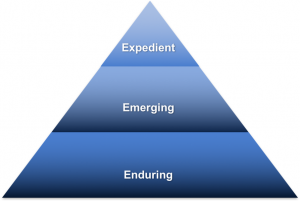Sustainability and EHS Strategies for the New Political Reality
Mar 28th, 2017 | By Scott Nadler | Category: Sustainability
We’ve seen the direction that the new Administration in the United States wants to take. Now the question is, what direction will your company take?
It’s clear that the Administration intends to follow through on its promises. Even without Congressional action, it will move to gut environmental regulation, reverse climate change policy, and prioritize jobs over environment, health, safety, or sustainability.
It’s less clear what US-based companies intend to do. Will they stay the course, following through on their own promises (made in sustainability reports and elsewhere)? Will they gut their EHS and sustainability programs, taking Administration policy as a signal of a very different “license to operate?” Will skeptical executives shut down sustainability activities they previously tolerated as a sop to stakeholders? Will they step up to help fill the leadership vacuum created by the public sector? Or will they hesitate and hedge, waiting to see which way the politics go?
If you have responsibility for your company’s sustainability/EHS (S/EHS) strategy, you can’t afford to wait. It’s important to review your approach now and see if it’s still “fit for purpose” in this changed and challenging context. Failing to do so risks losing momentum on key policies and programs or, worse, handing control over to those seeking to exploit the Administration’s signals.
Your review needs to take a new form, though. Repeating old “materiality” exercises and asking the same stakeholders the same questions won’t produce fresh perspective. Focusing only on “what’s changing now” will make your head hurt and make you over-react to short-term signals. Instead, asking three blunt questions can give you that needed fresh view.
Key Questions
Ask key internal leaders in a facilitated session if you can; ask yourself in the dead of night with a blank legal pad if you must. But ask.
- What is Enduring?
Start with what lasts, not with what is in flux. What part of your S/EHS promises, policies, and programs represent enduring beliefs and commitments?
Some of what’s enduring should be your company’s values. These are the things that your company genuinely believed in the past, believes now, and will continue to believe regardless of shifting tides. The famous J&J Credo is one example, articulating beliefs that are literally chiseled in stone.
Some of what’s enduring may be central to your company’s value. What parts of your brand, core markets, or long-term strategy depend on your visibility or credibility around certain issues? What parts of your long-term capital expenditure are based on facing the reality of post-peak coal, disaggregated energy production, or changing urban development and transportation?
When you combine values and value, are there issues that have to be part of your company’s on-going commitment? That commitment might be around any EHS or sustainability issue: climate change, sea level rise, fair trade, supplier social performance, gender rights, or any one of a hundred different issues.
What matters is that these commitments are your foundation. Regardless of current politics, if these are truly enduring commitments then the priority is to remind everyone of that, renew the consensus on what those are, and make sure they remain intact.

Illustration courtesy of Scott Nadler
- What is Emerging?
Building on these enduring issues, you can move to the second question: What are the emerging S/EHS issues that create opportunities or risks to your business?
Look forward, not backward. What are the issues that are starting to emerge that you need to pay attention to (regardless of how they arise)? Inequality and economic opportunity here in the US may be one of those issues, even if you don’t like the way those issues were handled in the recent election. No one is pushing your company to do anything about this now. But is it something you should begin to pay attention to and prepare for?
Similarly, investor attention to your S/EHS performance may be growing. For years, we’ve heard investor pressure discussed without seeing long-term systematic pressure from the investors themselves. That may be starting to change – and while it may be exacerbated by declining faith in government action (or fears of negative government action), the generational shift in investing may be starting to stick. As Morgan Stanley just noted:
…86 percent of Millennials — broadly defined as those born between the early 1980s and 2000 — say they are interested in socially responsible investing. Millennials are also twice as likely to invest in a stock or a fund if social responsibility is part of the value-creation thesis.
That might seem like the same vague view of a distant future — except now Morgan Stanley is starting to put its money (okay, your money) where its mouth is:
… [M]ost sustainable investing opportunities are perceived to cater to individuals with significant wealth, while Millennials are still early in earning years. In response, Morgan Stanley is launching the Impact Access Model Portfolios to provide access to diversified investments with reduced account minimums.
Is your company ready?
- What is Expedient?
Once you’ve focused on the enduring and emerging, then it’s time to ask: What are the short-term actions, statements, or silences that may be expedient in the current political climate?
There’s nothing wrong with paying attention to short term opportunities and threats. In fact, you’re ignoring your fiduciary responsibilities if you don’t consider them. Regulatory requirements or roadblocks may be dropping. Tax regulations or other costs may be shifting. Political favor is certainly being dispensed (or withheld) based on different criteria than in the past, rewarding or punishing companies seen as following the Administration’s agenda. At the same time, media, NGO, and investor (or at least analyst) attention may be shifting in different directions, including punishing companies for following the Administration’s agenda.
All of those things may be relevant to your company’s S/EHS approaches. They may create legitimate short-term opportunities for investment and grabbing market share. They may create short-term risks that argue for moving a little more slowly or speaking out a little more softly.
The key is that these expediencies all look different if you’ve already updated your strategies for what is enduring and emerging. What is left, what may be expedient, is only at the margin. For example, if you’ve reaffirmed that your long-term strategy is based on adjusting to the long-term decline in coal, then you are much less likely to be swayed by short-term cheerleading about ephemeral reversals in coal’s fortunes.
Ask, Listen, Act
The answers to these three questions will vary by company, of course. Listen to what the people in your company really say. Don’t assume they all agree with you. Don’t avoid the tough answers.
Your actions need to be based on those answers, but you are probably going to want to:
- Reaffirm the enduring issues and make sure senior management remembers and understands why those are important for your value, values or both
- Explore the emerging issues and make sure the relevant business leaders are aware of them.
- Expand and update your external network (and bring those changes into your materiality exercises) to help you assess and prepare for the emerging issues
The challenge is to find the right balance. Between the panic and the paralysis of daily headlines there is a point of calm, focused progress. Help your colleagues and company calm down about the expedient issues, capture opportunities and prepare for risks. Above all, don’t let your company over-react – and jeopardize its enduring value and values.
About the Author
Scott Nadler is Founding Principal at Nadler Strategies LLC, providing practical strategy and sustainability consulting, facilitation, and executive coaching. Scott is also Program Director with the U.S. Business Council for Sustainable Development, an action-oriented business association using collaborative projects, platforms, and partnerships to develop and implement solutions to sustainability challenges in the U.S. Current programs address ecosystems, energy, materials, and water challenges. Scott’s experience includes sustainability, environment, development, real estate, transportation, regulation, business-to-business (B2B) sales and customer service, and international collaboration. His approach is shaped by 40 years of hands-on experience building, leading, and turning around organizations and supporting senior executives in both the private and public sectors.
Photograph: Angel by Livia Korandy, Szombathely, Hungary.

